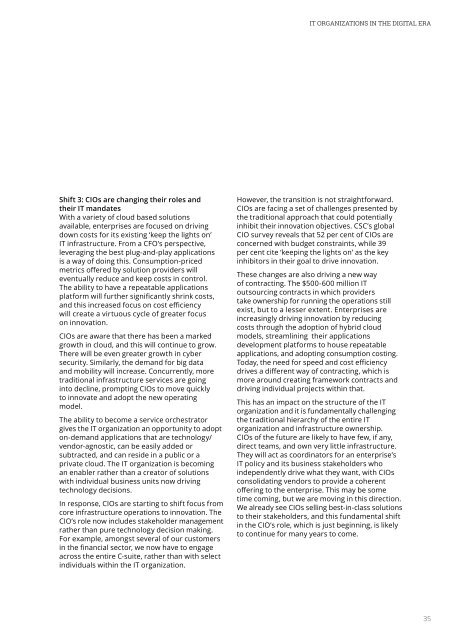IT Organizations in the Digital Era
ISG_Perspectives_Oct2016
ISG_Perspectives_Oct2016
You also want an ePaper? Increase the reach of your titles
YUMPU automatically turns print PDFs into web optimized ePapers that Google loves.
<strong>IT</strong> ORGANIZATIONS IN THE DIG<strong>IT</strong>AL ERA<br />
Shift 3: CIOs are chang<strong>in</strong>g <strong>the</strong>ir roles and<br />
<strong>the</strong>ir <strong>IT</strong> mandates<br />
With a variety of cloud based solutions<br />
available, enterprises are focused on driv<strong>in</strong>g<br />
down costs for its exist<strong>in</strong>g ‘keep <strong>the</strong> lights on’<br />
<strong>IT</strong> <strong>in</strong>frastructure. From a CFO’s perspective,<br />
leverag<strong>in</strong>g <strong>the</strong> best plug-and-play applications<br />
is a way of do<strong>in</strong>g this. Consumption-priced<br />
metrics offered by solution providers will<br />
eventually reduce and keep costs <strong>in</strong> control.<br />
The ability to have a repeatable applications<br />
platform will fur<strong>the</strong>r significantly shr<strong>in</strong>k costs,<br />
and this <strong>in</strong>creased focus on cost efficiency<br />
will create a virtuous cycle of greater focus<br />
on <strong>in</strong>novation.<br />
CIOs are aware that <strong>the</strong>re has been a marked<br />
growth <strong>in</strong> cloud, and this will cont<strong>in</strong>ue to grow.<br />
There will be even greater growth <strong>in</strong> cyber<br />
security. Similarly, <strong>the</strong> demand for big data<br />
and mobility will <strong>in</strong>crease. Concurrently, more<br />
traditional <strong>in</strong>frastructure services are go<strong>in</strong>g<br />
<strong>in</strong>to decl<strong>in</strong>e, prompt<strong>in</strong>g CIOs to move quickly<br />
to <strong>in</strong>novate and adopt <strong>the</strong> new operat<strong>in</strong>g<br />
model.<br />
The ability to become a service orchestrator<br />
gives <strong>the</strong> <strong>IT</strong> organization an opportunity to adopt<br />
on-demand applications that are technology/<br />
vendor-agnostic, can be easily added or<br />
subtracted, and can reside <strong>in</strong> a public or a<br />
private cloud. The <strong>IT</strong> organization is becom<strong>in</strong>g<br />
an enabler ra<strong>the</strong>r than a creator of solutions<br />
with <strong>in</strong>dividual bus<strong>in</strong>ess units now driv<strong>in</strong>g<br />
technology decisions.<br />
In response, CIOs are start<strong>in</strong>g to shift focus from<br />
core <strong>in</strong>frastructure operations to <strong>in</strong>novation. The<br />
CIO’s role now <strong>in</strong>cludes stakeholder management<br />
ra<strong>the</strong>r than pure technology decision mak<strong>in</strong>g.<br />
For example, amongst several of our customers<br />
<strong>in</strong> <strong>the</strong> f<strong>in</strong>ancial sector, we now have to engage<br />
across <strong>the</strong> entire C-suite, ra<strong>the</strong>r than with select<br />
<strong>in</strong>dividuals with<strong>in</strong> <strong>the</strong> <strong>IT</strong> organization.<br />
However, <strong>the</strong> transition is not straightforward.<br />
CIOs are fac<strong>in</strong>g a set of challenges presented by<br />
<strong>the</strong> traditional approach that could potentially<br />
<strong>in</strong>hibit <strong>the</strong>ir <strong>in</strong>novation objectives. CSC’s global<br />
CIO survey reveals that 52 per cent of CIOs are<br />
concerned with budget constra<strong>in</strong>ts, while 39<br />
per cent cite ‘keep<strong>in</strong>g <strong>the</strong> lights on’ as <strong>the</strong> key<br />
<strong>in</strong>hibitors <strong>in</strong> <strong>the</strong>ir goal to drive <strong>in</strong>novation.<br />
These changes are also driv<strong>in</strong>g a new way<br />
of contract<strong>in</strong>g. The $500-600 million <strong>IT</strong><br />
outsourc<strong>in</strong>g contracts <strong>in</strong> which providers<br />
take ownership for runn<strong>in</strong>g <strong>the</strong> operations still<br />
exist, but to a lesser extent. Enterprises are<br />
<strong>in</strong>creas<strong>in</strong>gly driv<strong>in</strong>g <strong>in</strong>novation by reduc<strong>in</strong>g<br />
costs through <strong>the</strong> adoption of hybrid cloud<br />
models, streaml<strong>in</strong><strong>in</strong>g <strong>the</strong>ir applications<br />
development platforms to house repeatable<br />
applications, and adopt<strong>in</strong>g consumption cost<strong>in</strong>g.<br />
Today, <strong>the</strong> need for speed and cost efficiency<br />
drives a different way of contract<strong>in</strong>g, which is<br />
more around creat<strong>in</strong>g framework contracts and<br />
driv<strong>in</strong>g <strong>in</strong>dividual projects with<strong>in</strong> that.<br />
This has an impact on <strong>the</strong> structure of <strong>the</strong> <strong>IT</strong><br />
organization and it is fundamentally challeng<strong>in</strong>g<br />
<strong>the</strong> traditional hierarchy of <strong>the</strong> entire <strong>IT</strong><br />
organization and <strong>in</strong>frastructure ownership.<br />
CIOs of <strong>the</strong> future are likely to have few, if any,<br />
direct teams, and own very little <strong>in</strong>frastructure.<br />
They will act as coord<strong>in</strong>ators for an enterprise’s<br />
<strong>IT</strong> policy and its bus<strong>in</strong>ess stakeholders who<br />
<strong>in</strong>dependently drive what <strong>the</strong>y want, with CIOs<br />
consolidat<strong>in</strong>g vendors to provide a coherent<br />
offer<strong>in</strong>g to <strong>the</strong> enterprise. This may be some<br />
time com<strong>in</strong>g, but we are mov<strong>in</strong>g <strong>in</strong> this direction.<br />
We already see CIOs sell<strong>in</strong>g best-<strong>in</strong>-class solutions<br />
to <strong>the</strong>ir stakeholders, and this fundamental shift<br />
<strong>in</strong> <strong>the</strong> CIO’s role, which is just beg<strong>in</strong>n<strong>in</strong>g, is likely<br />
to cont<strong>in</strong>ue for many years to come.<br />
35


